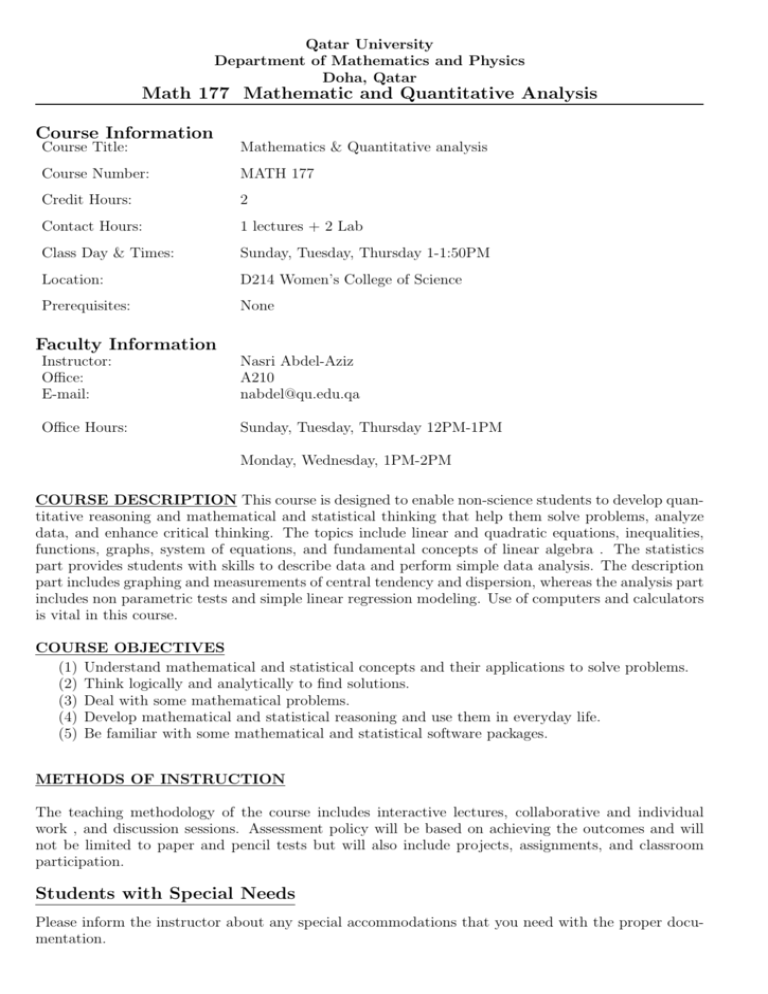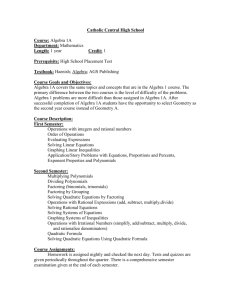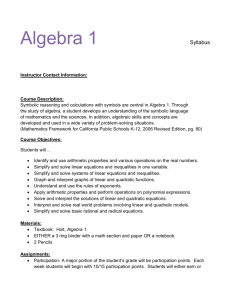Math 177 Mathematic and Quantitative Analysis Course Information
advertisement

Qatar University Department of Mathematics and Physics Doha, Qatar Math 177 Mathematic and Quantitative Analysis Course Information Course Title: Mathematics & Quantitative analysis Course Number: MATH 177 Credit Hours: 2 Contact Hours: 1 lectures + 2 Lab Class Day & Times: Sunday, Tuesday, Thursday 1-1:50PM Location: D214 Women’s College of Science Prerequisites: None Faculty Information Instructor: Office: E-mail: Nasri Abdel-Aziz A210 nabdel@qu.edu.qa Office Hours: Sunday, Tuesday, Thursday 12PM-1PM Monday, Wednesday, 1PM-2PM COURSE DESCRIPTION This course is designed to enable non-science students to develop quantitative reasoning and mathematical and statistical thinking that help them solve problems, analyze data, and enhance critical thinking. The topics include linear and quadratic equations, inequalities, functions, graphs, system of equations, and fundamental concepts of linear algebra . The statistics part provides students with skills to describe data and perform simple data analysis. The description part includes graphing and measurements of central tendency and dispersion, whereas the analysis part includes non parametric tests and simple linear regression modeling. Use of computers and calculators is vital in this course. COURSE OBJECTIVES (1) Understand mathematical and statistical concepts and their applications to solve problems. (2) Think logically and analytically to find solutions. (3) Deal with some mathematical problems. (4) Develop mathematical and statistical reasoning and use them in everyday life. (5) Be familiar with some mathematical and statistical software packages. METHODS OF INSTRUCTION The teaching methodology of the course includes interactive lectures, collaborative and individual work , and discussion sessions. Assessment policy will be based on achieving the outcomes and will not be limited to paper and pencil tests but will also include projects, assignments, and classroom participation. Students with Special Needs Please inform the instructor about any special accommodations that you need with the proper documentation. Assessments First Midterm Exam ( March 27 ) . . . . . . . . . . . . . . . . . . . . . . . . . . . . . . . . . . . Second Midterm Exam (May 15 ) . . . . . . . . . . . . . . . . . . . . . . . . . . . . . . . . . . . Comprehensive Final Exam . . . . . . . . . . . . . . . . . . . . . . . . . . . . . . . . . . . . . . . . . . Quizzes ( lowest quiz dropped ) . . . . . . . . . . . . . . . . . . . . . . . . . . . . . . . . . . . . . . . Assignments Homework (Exercises and Projects ) . . . . . . . . . . . . . . . . . . . . Class activities and group-work . . . . . . . . . . . . . . . . . . . . . . . . . . . . . . . . . . . . . . Total 15 % 15 % 35 % 10 % 10 % 10 % 100 % Grades A ( 90-100) B+ ( 85-89) B (80-84) C+ (75-79) C (70-74) D+ (65-69) D(60-64) F( 0-59) GENERAL INFORMATION: Class attendance is compulsory. In accordance with University regulations, a student’s absence cannot exceed 25 % of the total number (entire semester) of class meetings. If your absence rate exceeds 25 %, including both excused and unexcused absences, you will NOT be allowed to take the final examination and will receive an ‘F barred’ grade for the course. Three tardies will be counted as one class absence. All homework and assignments must be submitted to the instructor on time. No late assignments will be accepted. Students are responsible for obtaining material covered in class during their absence. Notify your instructors, in advance or in a timely manner, if you are unable to attend a class or submit a scheduled assignment. There is no curve in this class, the points you earn is the grade you earn. However, your lowest quiz grade will be dropped. ACADEMIC HONESTY POLICY: Academic dishonesty includes, but is not limited to, cheating on exams and quizzes, copying homework, plagiarism, and theft. Any occurrences of academic dishonesty will be dealt with on a case by case manner in accordance with QU policies. COURSE MATERIAL Texts: Fundamentals of Statistics. Michael Sullivan. III. Prentice Hall. College Algebra with Trigonometry. Barnett.,Ziegler and Byleen. Eighth Edition. McGRAAW.HILL Technology: Scientific calculators and access to the internet Additional Printed Resources (Available in the Library) • Fraser ,W.Roy. (1993).Intermediate Algebra, An Early Functions Approach, PWS-KENTPublishing Company. • Hirsch ,Lewis & Goodman ,Arther (1998). Understanding Algebra for College Students, Brooks/Cole Publishing Company. • Kaufmann ,Jerome E.. (1998). ,Elementary and Intermediate Algebra , ,Combined Approach. • Dugopolski,Mark. (2004). Elementary and Intermediate Algebra. Second Edition. Mc Graw Hill • Mann, Prem S. (1998). Introductory statistics. John Wiley • Wonnacott, Thomas H., Wonnacott, Ronald J. (1990). Introductory statistics .. John Wiley. • Riccardo Russo .(2003).Statistics for the Behavioural Sciences: an introduction.. Psychology Press. 2 Online Resources • The Real Number Line, Interval Notation and Set Notation: http://www.sosmath.com/algebra/inequalities/ineq02/ineq02.html • Solve Linear Inequalities: http://www.mathsnet.net/asa2/2004/c12ineqlin2.html • Algebra Topics: http://www.themathpage.com http://regentsprep.org/Regents/math/math-a.cfm http://www.wtamu.edu/academic/anns/mps/math/mathlab/beg_algebra/index.htm http://www.algebra-online.com/adding-substracting-like-fractions-1.htm http://www.algebrahelp.com http://www.math.com/school/subject2/lessons/S2U2L1GL.html#sm1 • Matrices and Matrix Operations: http://www.maths.surrey.ac.uk/interactivemaths/emmaspages/option1.html#Add • Algebra Topics including Matrices and Matrix Operations: http://www.purplemath.com/modules/index.htm http://www.intmath.com/Systems-of-equations/2_graphs-linear-functions.php • Statistics Topics: http://www.statsoft.com/textbook/esc.html http://davidmlane.com/hyperstat/ http://sofia.fhda.edu/gallery/statistics/lessons.html http://exploringdata.cqu.edu.au/ http://www.corporate.coventry.ac.uk/cms/jsp/polopoly.jsp?d=653 Web sites for practicing • Algebra topics: http://www.webmath.com/ Real numbers : http://people.hofstra.edu/faculty/stefan_Waner/RealWorld/tut_alg_review/framesA_ 1.html • Order pairs: http://www.terragon.com/tkobrien/algebra/topics/orderdpairs/op.html http://www.analyzemath.com/graphing_calculators/rectangular_coordinate.html • Graphing: http://www.langara.bc.ca/~acooper/GeX/v2/Grapher.htm • Linear function and graph: http://www.ies.co.jp/math/java/geo/lin_line/lin_line.html • Graphing quadratic functions: http://members.shaw.ca/ron.blond/QFA.CSF.APPLET/index.html http://www.analyzemath.com/quadraticg/quadraticg.htm 3 Week: Week 1 Feb 21-25 Topic Real Numbers and Intervals Evaluation Properties of Real numbers. Commutative .Associative .Distributive. Identity .Inverse Week 2: Fractions and Exponents: Feb 28-Mar 4 Addition, Multiplication and Division of fractions Positive integers .Fractional Week 3: Mar 7-11 Algebraic expressions Quiz 1 Addition and Subtraction of algebraic expressions Multiplication and Division of algebraic expressions Week 4: Mar 14-18 Equations. Linear Equation. Solving linear equations, linear equations involving fraction value, linear equations involving absolute value and linear Inequalities Week 5: Mar 21-25 Quadratic Equations and Applications. Solving quadratic equations by factoring, quadratic equations by taking square roots, quadratic equations by completing the square and quadratic equations by using the quadratic formula. Midterm 1 (March 27) Week 6: Quadratic Equations and Applications. Mar 28-Apr 1 The discriminant of quadratic equations. Applications of quadratic equations. Week 7: Apr 4-8 Functions Quiz 2 Domain , Co Domain and Range. Linear Functions, Slope and Graph of Linear Functions Quadratic Functions and graphing them. Week 8: SPRING BREAK - April 11 -15 Week 9: Apr 18-22 Matrices and Matrix Operations: Introducing Matrix Notation, Equality of Matrices ,and Operations on Matrices Addition and Subtraction, Scalars Multiples Introducing Matrix Multiplication. Solving system of two linear equations. Week 10: Introduction to statistical concepts; population, sample, vari- Quiz 3 able, data types. Apr 25-29 Frequency tables. Week 11: May 2-6 Bar and Pie charts, Histogram, Frequency Curve and Ogive. Week 12: Percentiles, measures of dispersion (Range, IQR, and Stan- Midterm II dard Deviation). Bivariate data, correlation coefficient. (May 15) May 9-13 Measures of location (mean median and mode) Week 12: May 16-20 Nominal measure (Kendall tau) of association. Week 13: May 23-27 Simple linear regression. Week 14: Applications to real life data Chi-square test of independence. Quiz 4 Use excel to fit simple linear regression model. 4







